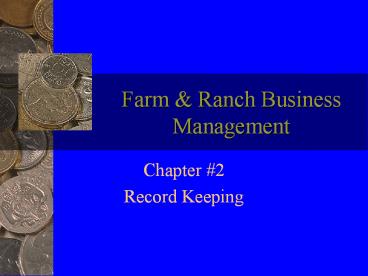Farm - PowerPoint PPT Presentation
Title: Farm
1
Farm Ranch Business Management
- Chapter 2
- Record Keeping
2
Why keep records?
- income tax reporting requirements
- assist in planning and management
- obtaining credit
3
What kinds of records need to be kept?
- 1) Cash Flow Statement monthly cash inflows and
outflows - 2) Net Worth Statement asset minus liabilities
- shows financial condition of business
- lists all assets values, liabilities values
- also known as a balance sheet
4
What kinds of records need to be kept?
- 3) Income Statement shows profit for a given
time (1 year) - also known as a Profit/Loss Statement
- 4) Detailed Enterprise Analysis identifies
factors that affect the profitability and
efficiency of the individual enterprises - Records allow you to compare past performance
with present performance and future goals
5
What kinds of records need to be kept?
- Cash Flow Projection estimate monthly cash
inflows and outflows - Whole Farm Budgets compares alternative courses
of action - Risk Management Plan statistical calculation of
the probabilities of success
6
What steps need to be taken to set up a record
system?
- 1) select a record keeping system suited to their
particular needs - 2) select an accounting system suited to your
business situation - 3) select a method of reporting farm income and
expenses - 4) develop a procedure to get exactly the
information needed from the records
7
What kinds of records are there?
- Financial
- receipts expenses
- net worth
- income statement
- cash flow
- Physical
- production records of crops/livestock
- crop yield
- birth, wean wt.
8
What are the types of accounting systems?
- Double entry system
- each credit transaction must be balanced by a
debit transaction - Single entry system
- no balance is maintained
9
What methods are used to report income and
expenses?
- 1) Cash Method records of actual cash
transactions - income expenses recorded in year that actually
received or paid - no inventory kept for unsold products or supplies
- cost of items bought for resale are not deducted
until year actually sold
10
Cash Method
- provides flexibility in choosing when to take
income and deduct expenses - if the farmer shows a profit, cash is available
to pay income taxes - expenses are not deducted until cash is paid
- inventories must be made to compute financial
statements - income may be erratic
11
Accrual Method
- income and expenses reported when they actually
occur - uses an inventory to match income expense to
the appropriate time period - levels out peaks and valleys in income
- detailed and complex required
- all items must be inventoried
12
Accrual Method
- easier to determine net farm income and analyze
the strengths and weaknesses of the farm business
from year to year - work with abstract figures (may only show profit
on paper) - actual cash position may be difficult to estimate
13
Record Keeping Procedures
- learn about record keeping system before you
begin - develop a habit of keeping record up to date
- do most business through a bank account (also
identify items on deposit slips borrowed money,
gift, bushels, pounds) - get the bank statement each month and reconcile
the checkbook and record keeping system
14
Record Keeping Steps
- enter the beginning of the year inventories
(owned assets, accounts payable, beginning cash
balance) - set up depreciation schedules
- enter receipts, expenses, and production records
- enter end of year inventories
- complete the farm analysis (income taxes,
financial statements, enterprise analysis, cash
flow)
15
What is an Inventory?
- list of all assets and values
16
Why keep an inventory?
- get a true picture (on net worth statement)
- beginning to ending inventory change
- must use in accrual method
- place a value on assets
17
What items are inventoried?
- all unsold items at end of tax year
- crops in storage
- raised livestock
- all items purchased for resale but not yet sold
- livestock
18
What items are inventoried?
- hedging contracts
- crop and livestock supplies
- capital assets
- breeding livestock
- machinery equipment
- buildings land
- accounts receivable payable
- liabilities
19
Guidelines for making inventories
- measure quantities in commonly used units
(bushels, tons, cwt., pounds) - group like items (cows, bulls, replacement
heifers, calves)
20
How do you place a value on inventory items?
- Cost minus depreciation
- Cost minus depletion value changes as resources
are removed (gravel pit) - Market cost actual cost (used within a short
time, feed, seed) - Net Market Price if you sell the product (wheat)
21
How do you place a value on inventory items?
- Farm Production Costs actual amount invested in
crop - Actual Amount value of liability owed
22
What are Cash Receipts?
- cash flowing into a business
- business income
- crop sales,Government payments, patronage
dividends (co-ops), resales (only net gain is
taxed), cash rent, Crop insurance payments,
raised nonbreeding livestock, capital sales,
wages, dividends received, stock distributions,
oil gas royalties, interest received from
savings, rental income, gifts, inheritance, life
insurance
23
What are Cash Expenditures?
- money flowing out of a business
- business expenses
- hired labor, repairs maintenance, interest
paid, feed, seeds, fertilizer chemicals,
machine hire, supplies (useful life lt1 yr.),
breeding fees, veterinary medicine, fuel oil,
storage, taxes (real estate, personal property),
insurance (on farm assets), utilities, cash rent,
freight trucking, items purchased for resale,
capital purchases, money paid on accounts
payable
24
Hired Labor Records
- social security and unemployment taxes may need
to be paid by employer
25
(No Transcript)































